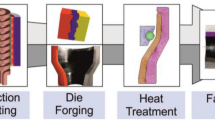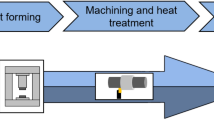Abstract
To fulfil future trends of machine elements, the surface and part properties need to be enhanced. To advance machine elements, the application of tailored forming technology offers new possibilities. With this approach, it is possible to design and manufacture machine elements consisting of two or more different metallic materials with improved performance and functionality specially adapted to their respective application. The process chain starts with the joining of different materials to multi-metal work pieces, which are subsequently formed close to the final contour. The properties of the joining zone can be improved by thermal and mechanical treatment accompanying the forming process.
Exemplary multi-metal components with a boundary zone subjected to rolling contact fatigue were investigated. Thus, an axial bearing, a shaft with an integrated raceway, a bearing bushing/angular contact ball bearing and a bevel gear wheel were in the focus of this research. Here, the highly stressed areas are reinforced with a higher strength material, while the rest of the part consists of a lower grade material. In case of the shaft, the raceway acts like the inner ring of a bearing and should resist rolling contact fatigue and mechanical wear. The process route was set up and simulations regarding the fatigue life in dependence of the layer thickness of the material acting as raceway were performed. First fatigue tests were executed to prove the reliability of the described concept.
Zusammenfassung
Um zukünftige Trends zur Weiterentwicklung von Maschinenelementen zu erfüllen, müssen die Oberflächen- und Bauteileigenschaften verbessert werden. Um Maschinenelemente weiter zu optimieren, bietet der Einsatz von Tailored Forming neue Möglichkeiten. Mit diesem Ansatz ist es möglich, Maschinenelemente aus zwei oder mehr Metallen mit verbesserter Leistung und Funktionalität auf den jeweiligen Anwendungsfall abgestimmt herzustellen. Die Prozesskette beginnt mit der Verbindung verschiedener Werkstoffe zu einem hybriden Werkstück, das anschließend zur Endgeometrie umgeformt wird. Die Eigenschaften der Fügezone können durch den Umformprozess sowie durch Wärmebehandlung und mechanische Nachbearbeitung verbessert werden.
Im Rahmen des Projektes werden exemplarisch Tailored Forming Bauteile bei Wälzkontaktermüdung untersucht. So standen ein Axiallager, eine Welle mit integrierter Laufbahn, eine Lagerbuchse bzw. Schrägkugellager und ein Kegelrad im Mittelpunkt dieser Forschung. Bei diesen Bauteilen werden die hochbeanspruchten Bereiche mit einem höherfesten Werkstoff verstärkt, während der Rest des Bauteils aus einem kostengünstigen und einfach zu verarbeitenden Werkstoff besteht. Besonderes Augenmerk wird auf die notwendige Materialstärke und die Integrität der Fügezone gelegt. Bei dem Beispiel der Welle wirkt die Laufbahn als Innenring eines Lagers und sollte der Wälzkontaktermüdung, mechanischen Verschleiß und Lastspannungen widerstehen. Dieses Maschinenelement weist verschiedene Anforderungen in einem Bauteil auf, wie z. B. Widerstand gegen strukturelle Belastungen und eine Oberfläche unter zyklischer Wälzkontaktermüdung. Das Grundmaterial kann nach Gewicht und Kosten ausgewählt werden, wenn grundsätzliche Anforderungen an die Gestaltfestigkeit erfüllt sind. Erste Ermüdungsversuche wurden durchgeführt, um die Zuverlässigkeit des beschriebenen Konzepts nachzuweisen.











Similar content being viewed by others
References
Coors T, Pape F, Poll G (2017) Concept for enhancing machine elements by residual stresses and tailored forming. In: Proceedings IAMOT 2017, International Association for Management of Technology (IAMOT), Vienna, Austria
Neubauer T (2016) Betriebs- und Lebensdauerverhalten hartgedrehter und festgewalzter Zylinderrollenlager. IMKT, Leibniz Universität, Hannover (Thesis)
Pape F, Neubauer T, Maiß O, Denkena B, Poll G (2017) Influence of residual stresses introduced by manufacturing processes on bearing endurance time. Tribol Lett 66(205):65–70
Merklein M, Johannes M, Lechner M, Kuppert A (2014) A review on tailored blanks production. J Mater Process Technol 214(2):151–164
DIN 51819: Mechanisch-dynamische Prüfung auf dem Wälzlagerschmierstoff-Prüfgerät FE8 – Teil 3: Verfahren für Schmieröl, einzusetzende Prüflager, Axialzylinderrollenlager
Pape F, Coors T, Barroi A, Hermsdorf J, Mildebrath M, Hassel T, Kaierle S, Matthias T, Bonk C, Chugreeva A, Bonhage M, Bouguecha A, Behrens BA, Overmeyer L, Poll G (2017) Tribological investigations on tailored formed axial bearing washers. Proceedings, WTC2017, 6th World Tribology Congress, Beijing, 17.–22. September 2017, p 4
Coors T, Pape F, Poll G (2018) Enhancing machine elements by residual stresses, optimized surfaces and tailored forming. In: Proceedings 21st International Colloquium Tribology, TAE, Esslingen, pp 277–278
Meyer C (2010) Reibung in hoch belasteten EHD-Wälzkontakten. IMKT, Leibniz Universitaet, Hannover (Thesis)
Ioannides E, Bergling G, Gabelli A (1999) An analytical formulation for the life of rolling bearings. Acta polytechnica Scandinavica, mechanical engineering series, 137
Lundberg G, Palmgren A (1947) Dynamic capacity of rolling bearings. Generalstabens litografiska Anstalts Förl., acta polytechnica. Mechanical engineering series
DIN ISO 281: Rolling bearings – Dynamic load ratings and rating life (2007)
Van Dang K, Griveau B, Message O (1989) On a new mulitiaxial fatigue criterion: theory and application. In: Mechanical engineering publications, pp 479–496
Roessle ML, Fatemi A (2000) Strain-controlled fatigue properties of steels and some simple approximations. Int J Fatigue 22(6):495–511
Papadopoulos I (1997) A comparative study of multiaxial high-cycle fatigue criteria for metals. Int J Fatigue 19:219–235
Crossland B (1956) Effect of large hydrostatic pressure on the torsional fatigue strength of an alloy steel. In: Proc. Int. Conf. on fatigue of metals, institution of mechanical engineers, pp 138–149
Liu Y, Mahadevan S (2005) Multiaxial high-cycle fatigue criterion and life prediction for metals. Int J Fatigue 27:790–800
Cerullo M (2013) Application of Dang Van criterion to rolling contact fatigue in wind turbine roller bearings under elastohydrodynamic lubrication conditions, Proceedings of the Institution of Mechanical Engineers. Part C: J Mech Eng Sci 228(12):2079–2089
Ciavarella M, Monno F, Demelio G (2006) On the dang van fatigue limiting rolling contact fatigue. Int J Fatigue 28(8):852–863
Pape F, Coors T, Wang Y, Poll G (2019) Fatigue life calculation of load-adapted hybrid angular contact ball bearings, lecture notes in mechanical engineering. Proceedings of the 7th International Conference on Fracture Fatigue and Wear. Springer, Berlin, Heidelberg, pp 401–414
Cerullo M (2013) Application of Dang Van criterion to rolling contact fatigue in wind turbine roller bearings. In: 13th International Conference on Fracture Beijing
Acknowledgements
The results presented in this paper were obtained within the Collaborative Research Centre 1153 “Process chain to produce hybrid high performance components by Tailored Forming” in the subproject C3. The authors would like to thank the German Research Foundation (DFG) for the financial and organizational support of this project.
Author information
Authors and Affiliations
Corresponding author
Rights and permissions
About this article
Cite this article
Pape, F., Coors, T. & Poll, G. Investigations on tailored forming components as tribologically loaded machine elements. Forsch Ingenieurwes 82, 311–318 (2018). https://doi.org/10.1007/s10010-018-0284-y
Received:
Published:
Issue Date:
DOI: https://doi.org/10.1007/s10010-018-0284-y




